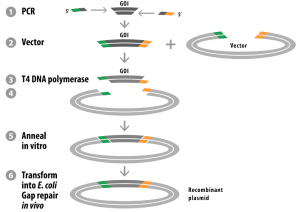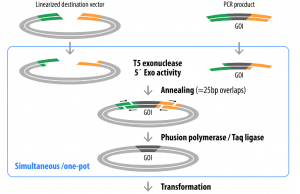Sequence and Ligation Independent Cloning (SLIC) is a method that makes use of annealing of single-stranded complementary overhangs on the target vector and a PCR-generated insert of approximately 15 – 40 bases.
Classical SLIC is based on the 3’ → 5’ exonuclease activity of the enzyme T4 DNA polymerase. In the first step, a PCR fragment is generated using primers that contain 5’ homologous regions (~ 20-40 bps) to the vector ends where the gene of interest will be inserted. The vector is linearized either by PCR as well or by restriction enzyme digestion. Both the insert and linearized vector are then treated with T4 DNA polymerase in the absence of dNTP’s, after which dCTP is added to stop the reaction. Both fragments will then have complementary overhangs to allow in vitro annealing. The efficiency of the annealing reaction can be increased by adding a small amount of Recombinase A (RecA) protein. After transformation into E. coli, the remaining gap will be repaired in vivo.
Gibson assembly cloning is another very popular sequence and ligation independent cloning method. It’s a very fast, highly efficient 1-tube reaction performed at 50ºC that is based on the actions of 3 different enzymes, which are T5 exonuclease, Phusion polymerase and Taq ligase. You also start from a PCR fragment with homologous ends to the region of the vector where you want to insert your gene of insert and a linearized vector. The T5 exonuclease, which is heat-labile, has a 5’ → 3’ exonuclease activity, generating complimentary overhangs that can be annealed in vitro. Phusion polymerase fills in the gaps after annealing and Taq ligase seals the nicks, after which the reaction mixture can be transformed into E. coli.
In-Fusion cloning is a ligation-independent cloning method that requires only 15 base overhangs and also allows very fast and efficient subcloning. It is based on a commercially available kit from Takara Bio. More information about this method can be found on the manufacturer’s website.

